Related Research Articles

Barnstaple is the main town of North Devon, England and possibly the oldest borough in the United Kingdom. It is a former river port, located at the lowest crossing point of the River Taw, flowing into the Bristol Channel.

North Devon is a local government district in Devon, England. North Devon Council is based in Barnstaple. Other towns and villages in the North Devon District include Braunton, Fremington, Ilfracombe, Instow, South Molton, Lynton and Lynmouth. The district was formed on 1 April 1974 as a merger of the Barnstaple municipal borough, the Ilfracombe and Lynton urban districts, and the Barnstaple and South Molton rural districts.
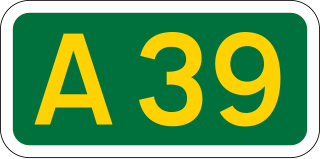
The A39 is an A road in south west England. It runs south-west from Bath in Somerset through Wells, Glastonbury, Street and Bridgwater. It then follows the north coast of Somerset, Devon and Cornwall through Williton, Minehead, Porlock, Lynmouth, Barnstaple, Bideford, Stratton, Camelford, Wadebridge and St Columb Major. It then joins the route of the A30 road for around 5 miles (8.0 km), re-emerging near Zelah to head for the south Cornish coast via Truro and Falmouth.

The Bideford Railway Heritage Centre CIC in Devon, England, is responsible for the management of the Bideford station site. The Company is also responsible for Instow signal box which opens on occasional Sundays and bank holidays from Easter to October.
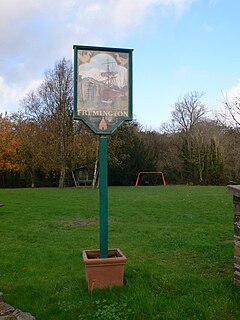
Fremington is a large village, civil parish and former manor in North Devon, England, the historic centre of which is situated three miles (5 km) west of Barnstaple. The village lies between the south bank of the tidal estuary of the River Taw and a small inlet of that river known as Fremington Pill. The parish is surrounded clockwise from the north by the parishes of Heanton Punchardon, Ashford, West Pilton, Barnstaple, Tawstock, Horwood, Lovacott and Newton Tracey, and Instow.
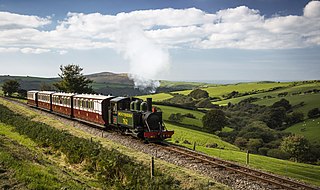
The Lynton & Barnstaple Railway (L&B) opened as an independent railway in May 1898. It was a single track, 1 ft 11 1⁄2 in narrow gauge railway and was slightly over 19 miles (31 km) long running through the rugged and picturesque area bordering Exmoor in North Devon, England. Although opened after the 1896 Light Railways Act came into force, it was authorised and constructed prior to that act. Therefore, as with all other railways, it was authorised under its own Act of Parliament and built to higher standards than similar railways of the time. In the United Kingdom it was notable as being the only narrow gauge line required to use main-line standard signalling. For a short period the line earned a modest return for shareholders, but for most of its life the L&B made a loss. In 1923 the L&B was taken over by the Southern Railway, and eventually closed in September 1935.

A community interest company (CIC) is a type of company introduced by the United Kingdom government in 2005 under the Companies Act 2004, designed for social enterprises that want to use their profits and assets for the public good. CICs are intended to be easy to set up, with all the flexibility and certainty of the company form, but with some special features to ensure they are working for the benefit of the community. They have proved popular and some 10,000 registered in the status's first 10 years.

Woody Bay is a bay on the North Devon coast of England, three miles west of Lynton and eight east of Combe Martin with a stony beach. It lies in the civil parish of Martinhoe at the edge of the Exmoor National Park and is a waypoint on the South West Coast Path. There were once plans to develop the area to become a holiday resort.
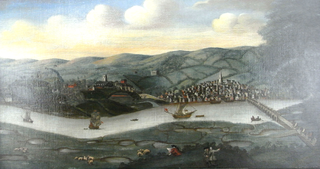
The ancient and historic village of Pilton is today a suburb within the town of Barnstaple, one of the oldest boroughs in England. It is located about quarter of a mile north of the town centre in the English county of Devon, in the district of North Devon. In 2009, the Pilton (Barnstaple) ward had a population of 4,239 living in some 1,959 dwellings. It has its own infants and junior school, houses one of Barnstaple's larger secondary schools, and one of Barnstaple's SEN specialist schools. North Devon Hospital is also within West Pilton parish. It has a Church Hall, two public houses, two hotels, and residential homes. It has residential estates of both private and public housing including flats. It also has a historic Church that dates back to at least the 11th Century.

Chelfham railway station was a station on the Lynton and Barnstaple Railway, a narrow gauge line that ran through Exmoor from Barnstaple to Lynton and Lynmouth in North Devon, England. The station stood at the head of the spectacular Chelfham Viaduct, and served the village of Chelfham below.

Lynton and Lynmouth railway station was the terminus of the Lynton and Barnstaple Railway, a narrow gauge line that ran through Exmoor from Barnstaple to Lynton and Lynmouth in North Devon, England. The station served the twin towns of Lynton and Lynmouth.
Parracombe railway station was a halt on the Lynton & Barnstaple Railway, a narrow gauge line that ran through Exmoor from Barnstaple to Lynton and Lynmouth in North Devon, England. The Halt which served the village of Parracombe comprised a simple wooden shelter and was not opened until 1 May 1899 — almost a year after the line was opened on 16 May 1898 — and closed along with the rest of the railway on 29 September 1935. It is planned this station will be reopened next by the Lynton & Barnstaple Trust. It will replace the station at Killington Lane a bit further to the north that was opened in 2006.
Snapper Halt railway station was a station on the Lynton and Barnstaple Railway, a narrow gauge line that ran through Exmoor from Barnstaple to Lynton and Lynmouth in North Devon, England. The station served a rural area near the hamlet of Snapper.
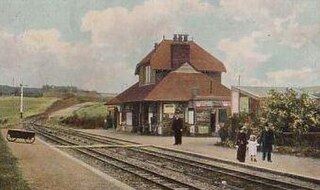
Woody Bay, within the Exmoor National Park, is a station on the former Lynton and Barnstaple Railway, a narrow gauge line that ran through Exmoor from Barnstaple to Lynton and Lynmouth in North Devon. The station was situated inland, about 2 km from Woody Bay itself.
Pilton Yard, in Barnstaple was, between 1898 and 1935, the main depot and operating centre of the Lynton and Barnstaple Railway ('L&B'), a narrow gauge line that ran through Exmoor from Barnstaple to Lynton and Lynmouth in north Devon, England. Pilton station was served by regular passenger services advertised between 1898 and 1904 after which only goods facilities were provided. Passengers were catered for at the nearby LSWR station, Barnstaple Town, which provided connections with trains on the standard gauge branch line to Ilfracombe. The L&B's main offices were also based at Pilton, in a building formerly belonging to the Tannery which had earlier occupied the site, and which took over the site after the railway closed.
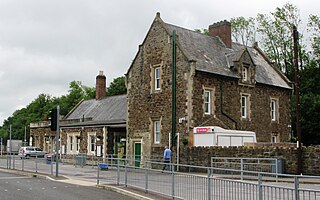
Barnstaple railway station is the northern terminus of the Tarka Line and serves the town of Barnstaple, Devon. It is 211 miles 25 chains (340.1 km) down-line from London Waterloo via Exeter St Davids. It is managed by Great Western Railway, which also operates the train service.
The Lynton & Barnstaple Railway Trust is an educational charity supporting the rebuilding and operation of the railway by the Lynton & Barnstaple Railway Company, in North Devon, England.

The Ilfracombe branch of the London & South Western Railway (LSWR), ran between Barnstaple and Ilfracombe in North Devon. The branch opened as a single-track line in 1874, but was sufficiently popular that it needed to be upgraded to double-track in 1889.

The Tarka Valley Railway in Devon, England, is a proposed heritage railway based on plans to rebuild the Barnstaple to Halwill Junction railway line. So far only a short demonstration line has been set up, and planning permission was granted for 300 ft of track in the direction of Bideford. The railway has been fenced off from the Tarka Trail ensuring the safety of all involved. Restoration of various items of railway stock is currently under way.

Martinhoe is a small settlement and civil parish in North Devon district of Devon, England. Martinhoe is within the Exmoor National Park, the smallest National Park in England. In the 2011 census Martinhoe Parish was recorded as having a population of 159. Martinhoe is in the Combe Martin ward, for elections to the district council. Martinhoe's local government takes the form of a parish meeting and as such has no parish council nor elected parish councillors.
References
- ↑ Bloggs, Barney (7 May 2010). "Lynton & Barnstaple Railway Company Ltd". UK: North Devon Journal. Retrieved 5 May 2015.